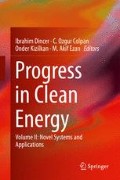Abstract
Geophysical exploration of geothermal resources deals with measurements on the physical properties of the Earth with two methods. First, the vertical electrical sounding (VES) method which is useful in determining the depth of overburden and depth, structure, and resistivity of flat-lying sedimentary beds and possibly of the basement also if it is not too deep. Furthermore the search for geothermal reservoirs normally involves resistivity surveying, and it is also employed routinely in groundwater exploration, which is of increasing worldwide importance. Second, spontaneous potential (SP) method is applied for determining the possible faults and finding the places with and without the liquid flow in the study area. At the SP graphic is analyzed that the natural voltage in a few measuring points varied between +28 mV and −48 mV values. At the natural potential, the plus (+) and minus (−) transitions indicate faulting zone. In this work, VES and SP methods at Kızılcahamam (Ankara) geothermal area were used to delineate location of aquifer zones and site wells or estimate properties of the system. Schlumberger electrode arrays were used in the VES measurements at 60 point in the study area. Schlumberger soundings at the study area have been carried out to try and estimate the bedrock resistivity at different depths. The measured quantity at the study area was called apparent resistivity. Interpreting the resistivity data consists of two steps: first, a physical interpretation of the measured data, resulting in a physical model, and second, a geological interpretation of the resulting physical model. The resistivity structure at study area is dominated by two coherent low resistivity layers that underlie most of the field. The shallower layer (<10 Ωm) lies within 300 m depth, while the deeper one is at about 900 m depth. Resistivity of rocks depends on porosity, saturation, content of clay, and resistivity of pore water. As a result of all these studies, geothermal anomalies having low resistivity values at the five different VES points have been identified. For geothermal drilling of the suggested VES, points constitute the appropriate fields.
Access this chapter
Tax calculation will be finalised at checkout
Purchases are for personal use only
References
Dagistan H, Dogdu N, Karadaglar M (2010) Geothermal explorations and investigations by MTA in Turkey. In: Proceedings World Geothermal Congress, Bali, Indonesia, 25–29 Apr 2010
Hersir GP, Björnsson A (1991) Geophysical exploration for geothermal resources, principles and applications. UNU-G.T.P, Iceland, report 15. pp 94
Hacısalihoğlu I (1999) Ankara-Çamlıdere-Peçenek-Bolu-Gerede-Aktaş-Salur-Dereköy field, geothermal energy explorations. Geophysic survey report, General Directorate of Mineral Research and Exploration of Turkey (MTA), Ankara, Turkey
Corwin RF (1990) The self-potential method for environmental and engineering applications. In Ward SW (ed) Geotechnical and Environmental Geophysics I: 127–145
Akasako H (2011) General process of geothermal power development (geothermal technologies for exploration and resource evaluation). West Japan Engineering Consultants, Inc., Compiled by: Fujii k, pp1–48
Kaya T (2005) Characterization of Kizilcahamam geothermal field by tracer testing. MSc. Thesis, Graduate School of Natural and Applied Sciences of Middle East Technical University, Ankara, Turkey
Kurtman F, Samilgil E (1976) Geothermal energy possibilities, their exploration and evaluation in Turkey. In: Proc. 2nd U.N. symposium on the development and geothermal resources, San Francisco, CA, pp 447–457
Simsek S, Okandan E (1990) Geothermal energy development in Turkey. Geothermal Resources Council Trans 14:257–266
Keskinsezer A, Beyhan G (2013) Geothermal modeling of Kizilcahamam-Çamlidere area using 3D imaging technique. Geomaterials 3:126–131
Toker M, Durak S (1990) Kızılcahamam KHD-1 ve MTA-1 wells, Test report. General Directorate of Mineral Research and Exploration of Turkey (MTA), Ankara, Turkey
Darnet M, Maineult A, Marquis G (2004) On the origins of self-potential (SP) anomalies induced by water injections into geothermal reservoirs. Geophys Res Lett 31: L19609, DOI:10.1029/2004GL020922
Acknowledgment
The author is thankful to Geophysical Engineer Ahmet Lezgi that supports the achievement of VES and SP data at the study area.
Author information
Authors and Affiliations
Corresponding author
Editor information
Editors and Affiliations
Rights and permissions
Copyright information
© 2015 Springer International Publishing Switzerland
About this chapter
Cite this chapter
Karakilcik, H. (2015). Determination of Geothermal Fields at Kızılcahamam (Ankara) Using Vertical Electrical Sounding (VES) and Spontaneous Potential (SP) Methods. In: Dincer, I., Colpan, C., Kizilkan, O., Ezan, M. (eds) Progress in Clean Energy, Volume 2. Springer, Cham. https://doi.org/10.1007/978-3-319-17031-2_22
Download citation
DOI: https://doi.org/10.1007/978-3-319-17031-2_22
Publisher Name: Springer, Cham
Print ISBN: 978-3-319-17030-5
Online ISBN: 978-3-319-17031-2
eBook Packages: EnergyEnergy (R0)

